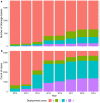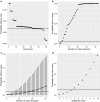Estimating the impact of Tiny Targets in reducing the incidence of Gambian sleeping sickness in the North-west Uganda focus
- PMID: 34407867
- PMCID: PMC8371857
- DOI: 10.1186/s13071-021-04889-x
Estimating the impact of Tiny Targets in reducing the incidence of Gambian sleeping sickness in the North-west Uganda focus
Abstract
Background: Riverine species of tsetse (Glossina) transmit Trypanosoma brucei gambiense, which causes Gambian human African trypanosomiasis (gHAT), a neglected tropical disease. Uganda aims to eliminate gHAT as a public health problem through detection and treatment of human cases and vector control. The latter is being achieved through the deployment of 'Tiny Targets', insecticide-impregnated panels of material which attract and kill tsetse. We analysed the spatial and temporal distribution of cases of gHAT in Uganda during the period 2010-2019 to assess whether Tiny Targets have had an impact on disease incidence.
Methods: To quantify the deployment of Tiny Targets, we mapped the rivers and their associated watersheds in the intervention area. We then categorised each of these on a scale of 0-3 according to whether Tiny Targets were absent (0), present only in neighbouring watersheds (1), present in the watersheds but not all neighbours (2), or present in the watershed and all neighbours (3). We overlaid all cases that were diagnosed between 2000 and 2020 and assessed whether the probability of finding cases in a watershed changed following the deployment of targets. We also estimated the number of cases averted through tsetse control.
Results: We found that following the deployment of Tiny Targets in a watershed, there were fewer cases of HAT, with a sampled error probability of 0.007. We estimate that during the intervention period 2012-2019 we should have expected 48 cases (95% confidence intervals = 40-57) compared to the 36 cases observed. The results are robust to a range of sensitivity analyses.
Conclusions: Tiny Targets have reduced the incidence of gHAT by 25% in north-western Uganda.
Keywords: Disease control; Elimination; Human African trypanosomiasis; Tiny Targets; Tsetse control; Uganda.
© 2021. The Author(s).
Conflict of interest statement
The authors declare that they have no competing interests.
Figures







References
-
- WHO . Report of a WHO meeting on elimination of African trypanosomiasis (Trypanosoma brucei gambiense) Geneva: WHO; 2010.
MeSH terms
Substances
LinkOut - more resources
Full Text Sources

